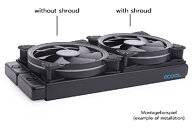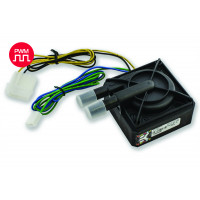- Joined
- Oct 9, 2007
- Messages
- 47,852 (7.39/day)
- Location
- Dublin, Ireland
| System Name | RBMK-1000 |
|---|---|
| Processor | AMD Ryzen 7 5700G |
| Motherboard | Gigabyte B550 AORUS Elite V2 |
| Cooling | DeepCool Gammax L240 V2 |
| Memory | 2x 16GB DDR4-3200 |
| Video Card(s) | Galax RTX 4070 Ti EX |
| Storage | Samsung 990 1TB |
| Display(s) | BenQ 1440p 60 Hz 27-inch |
| Case | Corsair Carbide 100R |
| Audio Device(s) | ASUS SupremeFX S1220A |
| Power Supply | Cooler Master MWE Gold 650W |
| Mouse | ASUS ROG Strix Impact |
| Keyboard | Gamdias Hermes E2 |
| Software | Windows 11 Pro |
Today, Alphacool presents the Fan Shroud & Decouplers for 120 mm and 140 mm fans, a must have for performance orientated liquid cooling enthusiasts. These silicon shrouds improve the performance of your liquid cooling system by optimising the airflow through the radiator.
The "dead spot" under the fan hub is overcome as air pressure builds up between the fan and radiator. The airflow is forced through the fins of the radiator as well as preventing air from escaping through gaps. This in turn also reduces the noise created from the escaping air as well as acting as a decoupler to dampen the vibrations being transmitted from the fan to the radiator and potentially to the case.




Alphacool also presents a 24-pin ATX PSU Jumper. This is a simple tool that allows you to power your pump whilst keeping the rest of the system dormant, this is particularly useful when you are filling a liquid cooling loop.

View at TechPowerUp Main Site
The "dead spot" under the fan hub is overcome as air pressure builds up between the fan and radiator. The airflow is forced through the fins of the radiator as well as preventing air from escaping through gaps. This in turn also reduces the noise created from the escaping air as well as acting as a decoupler to dampen the vibrations being transmitted from the fan to the radiator and potentially to the case.




Alphacool also presents a 24-pin ATX PSU Jumper. This is a simple tool that allows you to power your pump whilst keeping the rest of the system dormant, this is particularly useful when you are filling a liquid cooling loop.

View at TechPowerUp Main Site











